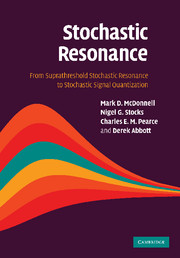Book contents
- Frontmatter
- Contents
- List of figures
- List of tables
- Preface
- Foreword
- Acknowledgments
- 1 Introduction and motivation
- 2 Stochastic resonance: its definition, history, and debates
- 3 Stochastic quantization
- 4 Suprathreshold stochastic resonance: encoding
- 5 Suprathreshold stochastic resonance: large N encoding
- 6 Suprathreshold stochastic resonance: decoding
- 7 Suprathreshold stochastic resonance: large N decoding
- 8 Optimal stochastic quantization
- 9 SSR, neural coding, and performance tradeoffs
- 10 Stochastic resonance in the auditory system
- 11 The future of stochastic resonance and suprathreshold stochastic resonance
- Appendix 1 Suprathreshold stochastic resonance
- Appendix 2 Large N suprathreshold stochastic resonance
- Appendix 3 Suprathreshold stochastic resonance decoding
- References
- List of abbreviations
- Index
- Biographies
8 - Optimal stochastic quantization
Published online by Cambridge University Press: 23 October 2009
- Frontmatter
- Contents
- List of figures
- List of tables
- Preface
- Foreword
- Acknowledgments
- 1 Introduction and motivation
- 2 Stochastic resonance: its definition, history, and debates
- 3 Stochastic quantization
- 4 Suprathreshold stochastic resonance: encoding
- 5 Suprathreshold stochastic resonance: large N encoding
- 6 Suprathreshold stochastic resonance: decoding
- 7 Suprathreshold stochastic resonance: large N decoding
- 8 Optimal stochastic quantization
- 9 SSR, neural coding, and performance tradeoffs
- 10 Stochastic resonance in the auditory system
- 11 The future of stochastic resonance and suprathreshold stochastic resonance
- Appendix 1 Suprathreshold stochastic resonance
- Appendix 2 Large N suprathreshold stochastic resonance
- Appendix 3 Suprathreshold stochastic resonance decoding
- References
- List of abbreviations
- Index
- Biographies
Summary
As described and illustrated in Chapters 4–7, a form of stochastic resonance called suprathreshold stochastic resonance can occur in a model system where more than one identical threshold device receives the same signal, but is subject to independent additive noise. In this chapter, we relax the constraint in this model that each threshold must have the same value, and aim to find the set of threshold values that either maximizes the mutual information, or minimizes the mean square error distortion, for a range of noise intensities. Such a task is a stochastic optimal quantization problem. For sufficiently large noise, we find that the optimal quantization is achieved when all thresholds have the same value. In other words, the suprathreshold stochastic resonance model provides an optimal quantization for small input signal-to-noise ratios.
Introduction
The previous four chapters consider a form of stochastic resonance, known as suprathreshold stochastic resonance (SSR), which occurs in an array of identical noisy threshold devices. The noise at the input to each threshold device is independent and additive, and this causes a randomization of effective threshold values, so that all thresholds have unique, but random, effective values. Chapter 4 discusses and extends Stocks' result (Stocks 2000c) that the mutual information between the SSR model's input and output signals is maximized for some nonzero value of noise intensity. Chapter 6 considers how to reconstruct an approximation of the input signal by decoding the SSR model's output signal.
Information
- Type
- Chapter
- Information
- Stochastic ResonanceFrom Suprathreshold Stochastic Resonance to Stochastic Signal Quantization, pp. 248 - 290Publisher: Cambridge University PressPrint publication year: 2008
